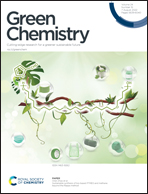Construction of an “environment-friendly” CuBx@PU self-supporting electrode toward efficient seawater electrolysis†
Abstract
It is of great significance to realize green development of high-efficiency and economical catalysts modified stably on the “white plastic” surface for grid-scale hydrogen production coupled plastic degradation by alkaline seawater splitting. Herein, needle-like copper–boron (CuBx) is successfully grown in situ on 3D porous polyurethane plastic (PU) via mild electroless plating to obtain the flexible CuBx@PU bifunctional self-supporting electrodes. Owing to its high intrinsic activity, fast electron transfer capacity and 3D loose porous morphology, overpotentials at 10 mA cm−2 in alkaline simulated seawater during the hydrogen evolution reaction (HER) and the oxygen evolution reaction (OER) are only η10 = 70 mV and η10 = 136 mV. The robust electrode only requires 1.45 V to achieve overall water splitting and can continuously work for over 20 h at 100 mA cm−2. Meanwhile, a series of CuBx-based ternary catalysts are simply modified on a plastic surface by this universal strategy with excellent catalytic performance. Attractively, the CuBx modification layer accelerates plastic aging and breaking down into small molecules of ammonia-ester after long-term seawater electrolysis at an industrial current density (>1 A cm−2). This work proposes a meaningful method for theoretical and practical application of green hydrogen production coupled “white pollutant” degradation.



 Please wait while we load your content...
Please wait while we load your content...